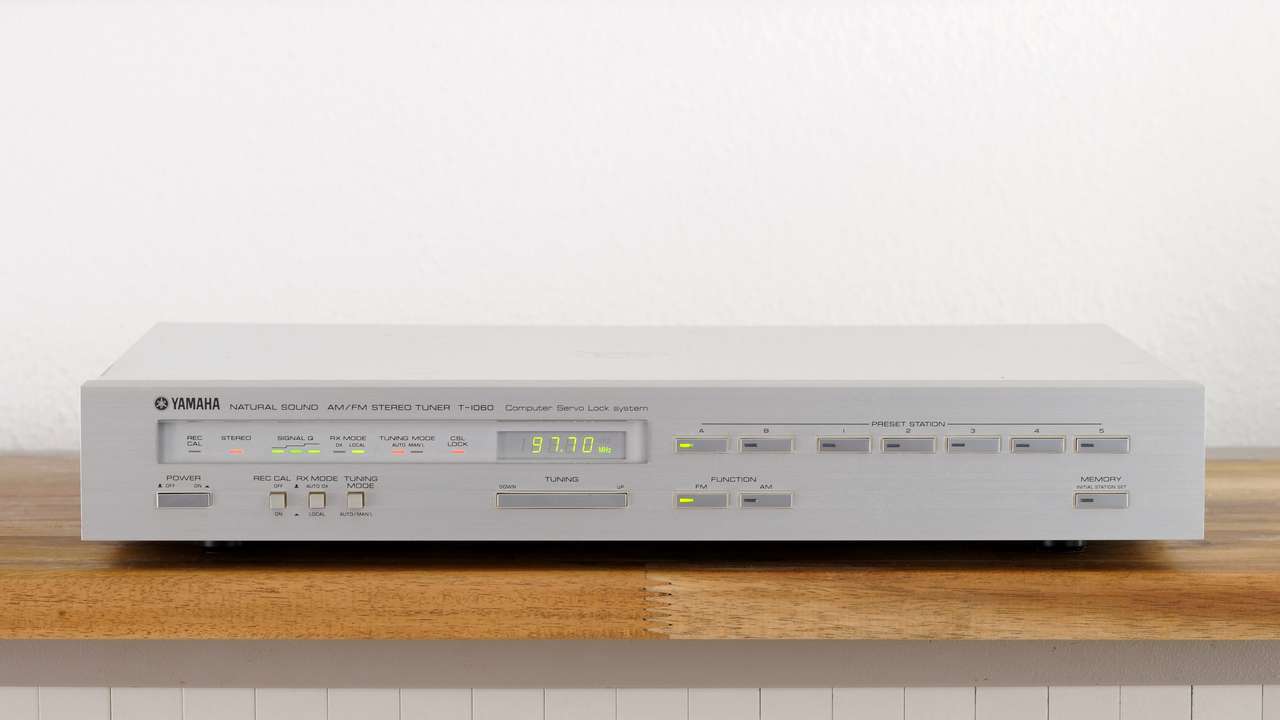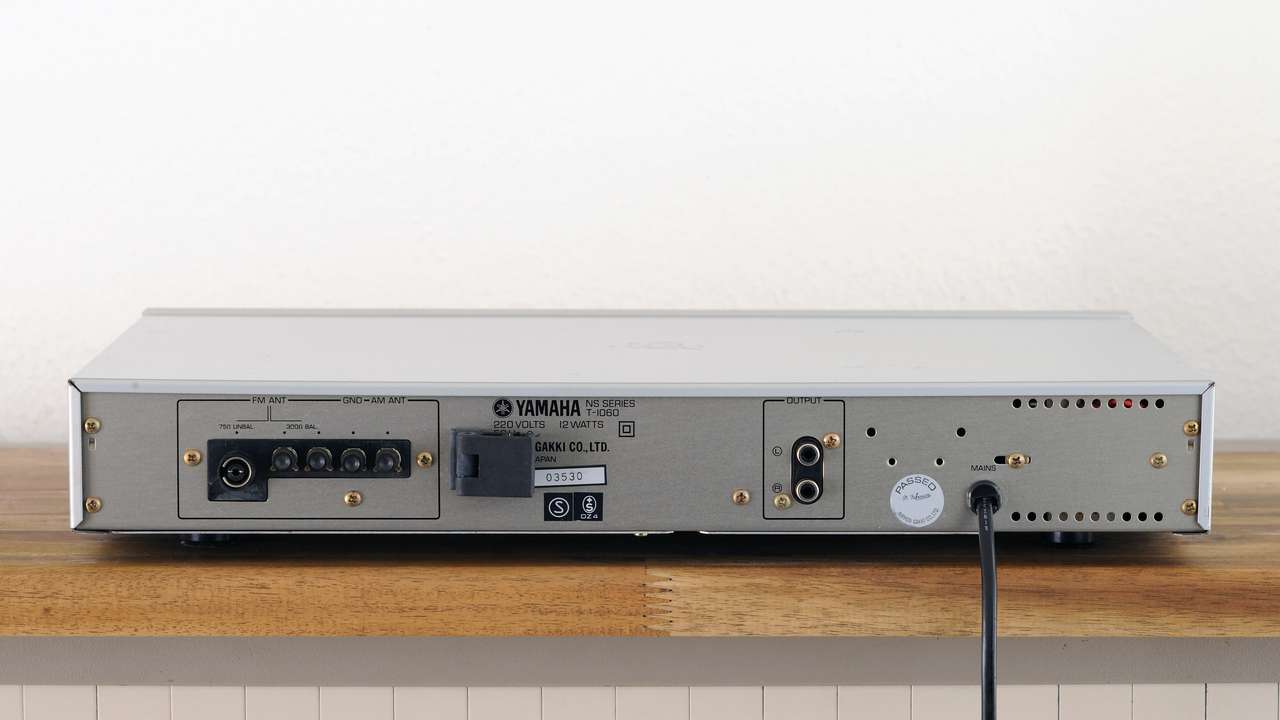Difference between revisions of "Yamaha T-1060"
(→Daten) |
(→Daten) |
||
| (3 intermediate revisions by 2 users not shown) | |||
| Line 1: | Line 1: | ||
__NOTOC__ | __NOTOC__ | ||
| − | == | + | == Data == |
| − | {{ | + | {{navigation}} |
| − | ''' | + | '''General''' |
| − | * | + | * Manufacturer: [[Yamaha]] |
| − | * | + | * Model: T-1060 |
| − | * | + | * Years of manufacture: 1981-1982 |
| − | * | + | * Made in: Japan |
| − | * | + | * Color: silver |
| − | * | + | * Remote control: No |
| − | * | + | * Power consumption: 12 watts |
| − | * | + | * Dimensions: 435 x 72 x 321 mm (WxHxD) |
| − | * | + | * Weight: 4 Kg |
| − | * | + | * Original price approx.: 408,- € (1981: 798,- DM) |
| − | ''' | + | '''Connections''' |
| − | * | + | * Number of inputs: |
| − | ** | + | ** Antenna FM (75 Ohm Unbalanced / 300 Ohm Balanced), AM. |
| − | * | + | * Number of outputs: |
| − | ** | + | ** Line Out: 300 mV / 600 Ohm |
| − | ''' | + | '''Technical Data''' |
| − | * | + | * Reception: |
| − | * | + | * Frequencies: |
| − | ** | + | ** VHF: 87.5-108 MHz |
** MW: 531-1621 kHz | ** MW: 531-1621 kHz | ||
| − | * | + | * Frequency response: |
| − | * | + | * Input sensitivity: 1.2/35 µV (mono/stereo according to DIN). |
| − | * | + | * Distortion factor: 0.03 |
| − | * | + | * Signal-to-noise ratio: 72 dB (stereo DIN) |
| − | * | + | * Channel separation: 60 dB |
| − | * | + | * Selectivity: 70 dB (DIN) |
| − | * | + | * Co-wave selection: 1.2 dB |
| − | * | + | * Spurious wave selection: 100 dB |
| − | * | + | * Image frequency attenuation: 85 dB |
| − | * | + | * IF attenuation: 100 dB |
| − | * AM | + | * AM suppression: 65 dB |
| − | * | + | * Output level: |
| − | * RDS: | + | * RDS: No |
| − | * | + | * Station memory: 10 |
| − | ''' | + | '''Special Features''' |
| − | * | + | * Level tone generator |
| − | * Narrow/Wide | + | * Narrow/Wide switching |
| − | == | + | == Remarks == |
| − | + | Other models in the same series: | |
| − | * | + | * identical black model -> [[Yamaha T-70|T-70]] |
* [[Yamaha T-760|T-760]] | * [[Yamaha T-760|T-760]] | ||
| − | + | Previous model: | |
* [[Yamaha CT-1010|CT-1010]] | * [[Yamaha CT-1010|CT-1010]] | ||
| − | + | Successor model: | |
* [[Yamaha T-1000|T-1000]] | * [[Yamaha T-1000|T-1000]] | ||
| − | == | + | == Pictures == |
http://img903.imageshack.us/img903/9804/M3XEhf.jpg | http://img903.imageshack.us/img903/9804/M3XEhf.jpg | ||
http://img908.imageshack.us/img908/9563/mZlyof.jpg | http://img908.imageshack.us/img908/9563/mZlyof.jpg | ||
| − | == | + | == Reports == |
| + | The device does not use a quartz as a reference for tuning, but a so-called micro tuning fork. | ||
| + | |||
| + | In the Funkschau 1981 a report about the tuner as well as about the technology of the micro tuning fork was published by the then Yamaha service manager Gernot Osburg. | ||
== Links == | == Links == | ||
| − | [[ | + | [[Category:Tuner]] |
Latest revision as of 10:55, 9 November 2020
Data
General
- Manufacturer: Yamaha
- Model: T-1060
- Years of manufacture: 1981-1982
- Made in: Japan
- Color: silver
- Remote control: No
- Power consumption: 12 watts
- Dimensions: 435 x 72 x 321 mm (WxHxD)
- Weight: 4 Kg
- Original price approx.: 408,- € (1981: 798,- DM)
Connections
- Number of inputs:
- Antenna FM (75 Ohm Unbalanced / 300 Ohm Balanced), AM.
- Number of outputs:
- Line Out: 300 mV / 600 Ohm
Technical Data
- Reception:
- Frequencies:
- VHF: 87.5-108 MHz
- MW: 531-1621 kHz
- Frequency response:
- Input sensitivity: 1.2/35 µV (mono/stereo according to DIN).
- Distortion factor: 0.03
- Signal-to-noise ratio: 72 dB (stereo DIN)
- Channel separation: 60 dB
- Selectivity: 70 dB (DIN)
- Co-wave selection: 1.2 dB
- Spurious wave selection: 100 dB
- Image frequency attenuation: 85 dB
- IF attenuation: 100 dB
- AM suppression: 65 dB
- Output level:
- RDS: No
- Station memory: 10
Special Features
- Level tone generator
- Narrow/Wide switching
Remarks
Other models in the same series:
- identical black model -> T-70
Previous model:
Successor model:
Pictures


Reports
The device does not use a quartz as a reference for tuning, but a so-called micro tuning fork.
In the Funkschau 1981 a report about the tuner as well as about the technology of the micro tuning fork was published by the then Yamaha service manager Gernot Osburg.